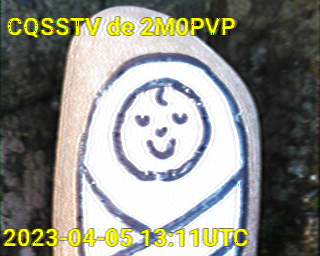Table of Contents
SSTV Basics
Introduction
SSTV is an umbrella term for a variety of image modes that work by converting a picture into sound and transmitting it over the radio. As the sound is separate from the radio, any SSTV mode can be transmitted over any radio modulation with enough bandwidth.
This article is a short guide to getting something working rather than an exhaustive guide to perfect outcomes.
The problem to be solved on reception is getting RF audio into a computer where an SSTV decoder can turn it into an image. The problem on transmission is getting the audio out of a computer and into a radio for transmission.
Frequencies and modes
The RSGB band plans have SSTV frequencies identified as Image Modes and they usually happen in the all modes segment of a band. Common frequency/modulation pairs are:
- 433.400MHz FM
- 144.500MHz FM
- 14.230MHz USB
- 7.165MHz LSB
Other bands are documented in the band plan, usually in the All Modes segment, and other countries have different options so it's worth looking around. Particularly on HF there are several common frequencies in case the main one is very busy.
Software
There are many programs for SSTV work and most will handle transmission and reception in one program, but that's not always the case.
- Windows: MMSSTV https://hamsoft.ca/pages/mmsstv.php
- Linux: QSSTV is almost certainly included in your distribution's package management tool: https://www.qsl.net/on4qz/qsstv/manual/gettingstarted.html
- Android: Robot36 is RX only. https://play.google.com/store/apps/details?id=xdsopl.robot36. SSTV encoder is TX only. https://play.google.com/store/apps/details?id=om.sstvencoder
- iPhone: TBC
- Apple computers: TBC
Get images now
The simplest way to get started is to install Robot36 onto an Android phone and open a WebSDR tuned to one of the HF options listed above. Robot36 will automatically listen to the output of the WebSDR and decode anything it can.
The same kind of setup can be done on any computer, but routing the audio output from the WebSDR into the audio input of the SSTV program can be challenging. Various “Virtual Audio Cable” programs exist which will create a virtual speaker which pipes anything sent to it to a virtual microphone. The Web browser and the SSTV program can be configured to use those devices. VB Cable has been used successfully for this on Windows, but many other options are available: https://www.dxzone.com/5-free-virtual-audio-cable-software/
Another simple method is to simply hold the speaker of a real radio near the microphone of your computer or smartphone. This kind of acoustic coupling is very simple to arrange but has the downside of being affected by ambient noise wherever you are.
Send images now
The first and important thing to consider is the duty cycle. Having listened to images being transmitted you should be familiar with how long it takes to send one. On some radio setups this can be too much work for some components. e.g. The SOTABeams band pass filter can handle 90s of TX at 5W. I would not want to put an SSTV image through it at that power.
Think about the capacity of your components before you key up. You do not want to end up in the Hall of Flame.
The acoustic coupling method for RX will also work on TX. Hold your device near your radio mic, press the PTT and press send on the SSTV program. Again, ambient noise is an issue, but good results can be had, even portable.
Many radios can be connected directly to computers, and data cables and data mod settings are very common, but exactly how to set that up for your radio is beyond the scope of this article. Join us on Discord #data-modes for advice on specific setups!
Important information to send
It's not just a case of sending pictures. There are license obligations and common standards. Every SSTV program will support adding text to your selected picture and you should always include your call sign as part of that.
Key text values are:
- CQ SSTV de <CALL SIGN>: for initiating a QSO
- <CALL SIGN> de <CALL SIGN>: for continuing a QSO
- RSV: Up to 595. Readability and Strength are the same as other modes, V for video indicates the quality of the received picture from 0 for no copy, 1 can make out text. 2 barely legible but lots of noise. 3 legible with noise. 4 Nearly perfect with some interference artefacts. 5 JPEG quality. 5 is rare! Usually a good QSO is around 3 or 4.
- Date/Time: Many SSTV programs have macro systems so you can tell it where the date/time should go and it will fill in the correct value on transmit.
Common fields are:
- Your Maidenhead locator
- A copy of the previously received image. Again this is usually handled automatically by the SSTV program.
Many SSTV programs will let you configure templates and macros to help quickly put relevant information into your next transmission so you don't get clobbered by people who think you've disappeared.
Improving quality
Improving quality is normally a process of eliminating interference. An obvious first step is to use a data cable of some sort instead of holding devices real close and hoping. A high contrast image can often help when conditions are moderate, as well as using the SSTV software to put contrasting borders around text to improve legibility.
Experiment and see what works for you
Hints and tips
- Experiment locally. Use your encoder and decoder together before ever including the radio. Record the output and replay it to decode. Test the sample file on Wikipedia . Once the audio paths are working, start incorporating a radio.
- On Android, SSTV Encoder has an option for picking “Favourites” from the phone gallery. Mark photos you'd like to send so you can select them quickly and easily.
- The Discord server has a #rx-captures channel for showing off your results.

